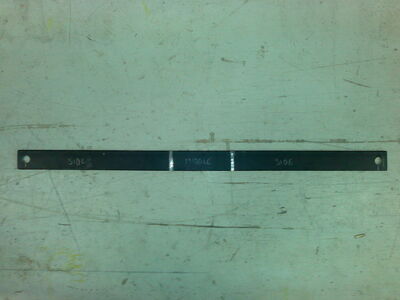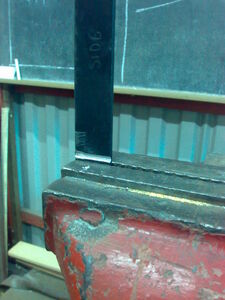Making the stirrup[]
A stirrup is required for crossbows which are cocked by hand or with cocking devices such as windlass, cord and pulley or belt and claw (see Payne-Gallway 1990: 73-80, 124). The purpose of the stirrup is to allow the crossbowman to keep the crossbow in place during cocking with his foot. Although there are only a few photographs in this article, many pictures are available in the Internet. A Google image search with "medieval crossbow stirrup" gives lots of good results.
The stirrup is by far the easiest component of the bow irons to make. The easiest material to make it from is flat steel 2-4cm wide and 0,3-0,5cm thick. The stirrup for a windlass crossbow can be relatively light, as it's stressed only a little during cocking. Stirrups for other types of crossbows should be much stronger or they'll bend.
To make a stirrup, cut appropriate length of the steel. Then, if you're using thick (4mm+) steel, grind shallow grooves at the correct places to make the bends cleaner. Make sure that the middle part (marked, below) is at least as wide as the stock of the crossbow plus the width of the sideplates. The side should be long enough so that your foot fits in the stirrup comfortably - with your boots on. Finally, drill rivet holes to both ends of the steel. These should be big enough to accommodate a round steel rod of appropriate strength (8-12mm).
Next attach the steel to a vise right next to the shallow groove, as in below picture
Now hammer one side to correct angle and repeat the same for the other side. The end should look like something between characters U and V.
Next cut a piece of round steel 8-12mm thick and and a little longer than the distance between the holes in the U-shaped piece of steel. The thickness of the rod is determined by the size of the holes in the flat piece of steel. Next form a shoulder (e.g. with a bench grinder) to the round rod's each end. After this slip the stirrup through the sideplates, insert the shoulders of the round steel rod to the holes in the U-shaped piece and rivet them together.
You can replace the round steel rod with a flat piece, in which case you need to bore a pair of holes to it's end so that you can rivet it to the U-shaped piece.
References[]
Alm, Josef [1994] 1998. European Crossbows, a survey. Royal armouries monograph 3. Dorset.
Payne-Gallwey, Ralph [1903] 1990. The crossbow. Medieval and modern, military and sporting. It's construction, history & management. Albert Saifer publisher. London.

